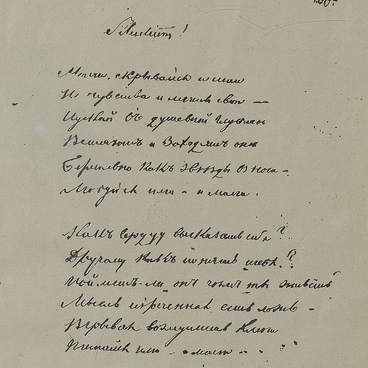There are few posthumous depictions of Fyodor Tyutchev. However, up to the present day, new generations of painters, graphic artists and sculptors continue creating portraits of the poet in different years.
The museum collection contains a picture of the Leningrad artist Boris Beltyukov, which was painted in 1985. It features the arrival of Fyodor Tyutchev in Ovstug during the feast of the Dormition of the Mother of God on August 28, 1855. On this day, which in the folk tradition was called ‘Spas’ (the Savior), apples, nuts and other crops were consecrated in the church; the poet’s family celebrated the name day of his daughter Maria.
Another daughter of Tyutchev, Daria, described this holiday, “We gained popularity among our peasants by throwing apples, gingerbread, bagels and coins from the balcony.” The poet himself is depicted in the picture surrounded by his family: his children Anna, Daria, Catherine, Maria, Ivan, Dmitry and his wife Ernestina Feodorovna. Tyutchev is in the center of the painting. He holds a cane in his right hand, and gloves and a top hat in his left.
The painting was specifically ordered for the exhibition in the restored estate in Ovstug. It makes it possible to see the entire Tyutchev family. The artist painted this work in soft pastel colors: white dresses, umbrellas, gloves, hats create an atmosphere of celebration. He does not emphasize Tyutchev against the background of the general composition, but, on the contrary, the artist puts the poet’s figure in harmony with the members of the family. To the right of Tyutchev, smartly dressed peasant women surround Ernestina Feodorovna. In the background, there is a manor house, a guest house and the Church of the Dormition. The background was painted by the artist based on a photograph of a watercolor painted by Dranitsyn in 1849. The watercolor has not been preserved.
Artists always portrayed Fyodor Tyutchev in a dark suit and light shirt according to the fashion trends of that time. Boris Beltyukov and other painters were greatly influenced by the images of the poet painted by his contemporaries during his lifetime. Tyutchev’s appearance did not always coincide with the generally accepted ideas about the poet. Another literary critic Vadim Kozhinov, for example, remarked, “This is a stern face, sunken cheeks, thin glasses, which make the appearance look even drier. He does not look like a poet.” In fact, Tyutchev’s appearance was quite characteristic, one might say, typical of his time.
The museum collection contains a picture of the Leningrad artist Boris Beltyukov, which was painted in 1985. It features the arrival of Fyodor Tyutchev in Ovstug during the feast of the Dormition of the Mother of God on August 28, 1855. On this day, which in the folk tradition was called ‘Spas’ (the Savior), apples, nuts and other crops were consecrated in the church; the poet’s family celebrated the name day of his daughter Maria.
Another daughter of Tyutchev, Daria, described this holiday, “We gained popularity among our peasants by throwing apples, gingerbread, bagels and coins from the balcony.” The poet himself is depicted in the picture surrounded by his family: his children Anna, Daria, Catherine, Maria, Ivan, Dmitry and his wife Ernestina Feodorovna. Tyutchev is in the center of the painting. He holds a cane in his right hand, and gloves and a top hat in his left.
The painting was specifically ordered for the exhibition in the restored estate in Ovstug. It makes it possible to see the entire Tyutchev family. The artist painted this work in soft pastel colors: white dresses, umbrellas, gloves, hats create an atmosphere of celebration. He does not emphasize Tyutchev against the background of the general composition, but, on the contrary, the artist puts the poet’s figure in harmony with the members of the family. To the right of Tyutchev, smartly dressed peasant women surround Ernestina Feodorovna. In the background, there is a manor house, a guest house and the Church of the Dormition. The background was painted by the artist based on a photograph of a watercolor painted by Dranitsyn in 1849. The watercolor has not been preserved.
Artists always portrayed Fyodor Tyutchev in a dark suit and light shirt according to the fashion trends of that time. Boris Beltyukov and other painters were greatly influenced by the images of the poet painted by his contemporaries during his lifetime. Tyutchev’s appearance did not always coincide with the generally accepted ideas about the poet. Another literary critic Vadim Kozhinov, for example, remarked, “This is a stern face, sunken cheeks, thin glasses, which make the appearance look even drier. He does not look like a poet.” In fact, Tyutchev’s appearance was quite characteristic, one might say, typical of his time.




